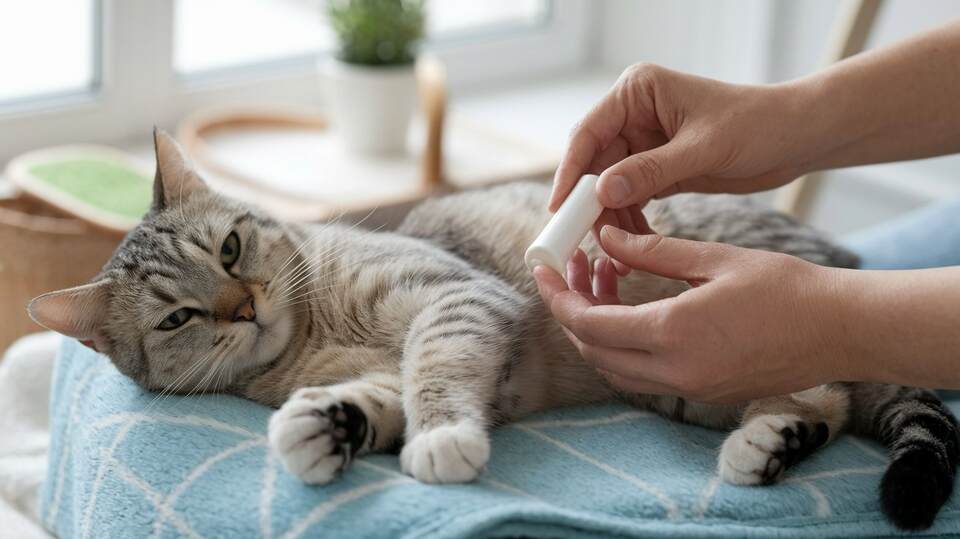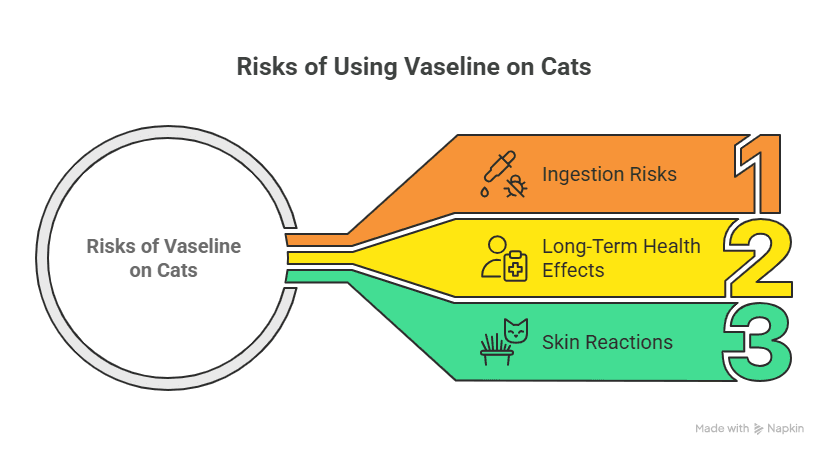
Introduction
You’re cleaning up after your cat or noticing a dry patch on their nose, and a thought pops into your head:
“Can I use Vaseline on my cat?”
After all, it’s a household staple—used for dry skin, cracked heels, chapped lips. So, it seems like a gentle fix for your furry friend, right?
But before you reach for that tub of petroleum jelly, it’s important to know:
Is Vaseline safe for cats?
In short: It’s not toxic—but it’s not ideal either.
This comprehensive guide will walk you through:
- What Vaseline actually is
- When (and how) it may be used on cats
- The risks and side effects
- Vet-backed alternatives that are safer
- Tips for common feline issues like hairballs, dry noses, and paw care
Let’s dive in and clear the confusion for good. 🐾
What Is Vaseline? (Petroleum Jelly Explained)
Vaseline is the brand name for a type of petroleum jelly, a semi-solid mixture derived from crude oil. It’s widely used by humans as a skin protectant due to its moisture-locking properties.
Vaseline is:
- Odorless
- Colorless or slightly yellow
- Made to create a protective barrier over skin
It’s generally considered safe for external human use, but cats are not humans, and that’s where it gets tricky.
Is Vaseline Safe for Cats? (The Short Answer)
Technically, Vaseline is not toxic to cats.
But “not toxic” doesn’t mean “completely safe.” It comes down to how you use it, how much, and where.
✅ Topical Use (Very Small Amounts):
Usually fine for short-term, external use—on dry noses, paw pads, or minor skin areas.
🚫 Oral/Ingested Use:
Not recommended. Cats lick everything. If ingested in large or repeated amounts, Vaseline can:
- Cause digestive upset
- Lead to long-term health issues like nutrient malabsorption
Why Do People Use Vaseline on Cats?
Cat parents often turn to Vaseline for DIY solutions, especially for:
🧴 1. Hairball Prevention
Vaseline has been a home remedy for hairballs, given orally to help move fur through the digestive tract.
🐾 2. Cracked Paw Pads
In dry seasons or winter months, paw pads can crack or peel. Vaseline acts as a moisture barrier.
👃 3. Dry Noses or Chapped Skin
Some use it to soothe dry noses or skin irritated from over-grooming or scratching.
💩 4. Constipation Relief
It’s sometimes used like a mild laxative to ease constipation, although this is not vet-approved.
While these uses are common in pet forums, they come with risks that you need to understand before applying anything.
Risks of Using Vaseline on Cats

Even though Vaseline is widely used, it isn’t always safe for feline use, especially without guidance.
🚨 1. Ingestion Risks
Cats are fastidious groomers. If you apply Vaseline anywhere on their body, they’ll likely lick it off. And while Vaseline isn’t acutely toxic:
- It isn’t digestible
- Can cause vomiting or diarrhea
- Can coat the intestines and interfere with nutrient absorption
🚨 2. Long-Term Health Effects
Frequent ingestion of petroleum jelly has been linked to:
- Vitamin deficiencies (due to interference with fat-soluble vitamin absorption)
- Chronic digestive irritation
- Liver strain
🚨 3. Skin Reactions
Although rare, Vaseline can trap bacteria or debris under the skin barrier, leading to:
- Infections
- Inflammation
- Greasy buildup that attracts dirt
When Is Vaseline Possibly Okay for Cats?
If you’re in a pinch, and your cat is otherwise healthy, there are a few specific cases where Vaseline might be used sparingly:
🧴 1. Hairballs (In Tiny Doses)
Some vets approve of 1/4 teaspoon of Vaseline once or twice a week to help move hair through the digestive system—only if the cat has no digestive issues and under vet supervision.
🐾 2. Cracked Paws or Nose (Externally Only)
Applying a tiny dab of Vaseline to a cat’s paw pads or dry nose:
- Can lock in moisture
- Should be done when your cat is resting, to prevent immediate licking
- Use only on small, unbroken skin areas
❗ Important:
- Never apply to open wounds or broken skin
- Never use daily or as a long-term solution
- Avoid if your cat has a history of GI issues, allergies, or pancreatitis
Cat-Safe Alternatives to Vaseline
There are much better options for grooming and minor skin issues that don’t carry the risks of petroleum jelly.
✅ 1. Hairball Control Gels (Vet-Formulated)
- Specifically made to lubricate the GI tract
- Often flavored and safe for cats
- Brands to consider: Laxatone, Nutri-Vet Hairball Remedy, Vet’s Best
✅ 2. Natural Oils (Used Sparingly)
- Coconut oil (small amounts, both topical and oral)
- Olive oil (tiny amounts mixed in food)
- Fish oil supplements (adds moisture from the inside out)
✅ 3. Pet-Safe Moisturizers
- Paw Soother by Natural Dog Company (safe for cats too)
- Vet’s Best Hot Spot Spray for irritated skin
- Aquaphor Healing Ointment (less risky than Vaseline, still should be used with care)
How to Safely Treat Common Cat Issues (Without Vaseline)
💨 Dry Nose
- Use a humidifier indoors
- Keep water bowls full and fresh
- Apply a tiny bit of pet-safe balm if needed
🐾 Cracked Paws
- Wipe paws after outside time
- Use cat-specific paw balm
- Add omega-3 supplements for skin support
💩 Hairballs or Constipation
- Add fiber (like pumpkin or psyllium)
- Try a vet-recommended hairball control food
- Groom regularly to reduce hair ingestion
👅 Over-Grooming or Irritation
- Rule out allergies or stress
- Use calming diffusers (Feliway)
- Provide interactive toys and stimulation
What If My Cat Already Ate Vaseline?
Don’t panic. If your cat licked a small amount, they’ll likely be okay.
✅ What To Do:
- Monitor for 24–48 hours
- Watch for vomiting, diarrhea, lethargy, or refusal to eat
- Call your vet if symptoms arise or worsen
If your cat consumed a large amount, especially straight from the jar, contact your vet immediately.
FAQs
Can I put Vaseline on my cat’s dry nose?
Yes, in very small amounts. Apply once and observe. Don’t use daily or on broken skin.
Is Vaseline safe for cat paws?
Sometimes, yes. Use only on dry/cracked paw pads and in tiny amounts. Distract your cat afterward to reduce licking.
Can Vaseline help with cat hairballs?
It can act as a laxative in small doses, but there are safer alternatives designed for cats. Always check with your vet first.
Is petroleum jelly toxic to cats?
No, it’s not technically toxic, but it can cause digestive problems and long-term health effects if ingested regularly.
What’s a better alternative than Vaseline for grooming?
Use a pet-specific balm, hairball gel, or natural oil. These are safer and formulated for cats’ skin and grooming habits.
Also Read - Do Cats Miss Their Owners? Understanding Feline Attachment and Separation
Conclusion
So, is Vaseline safe for cats?
✅ In short bursts and small amounts—maybe.
🚫 As a routine or ingestion-based treatment, not really.
While it isn’t toxic in the traditional sense, Vaseline is still petroleum-based and not meant for frequent cat use. If you’re dealing with:
- Hairballs
- Dry skin or paws
- Minor grooming concerns
…it’s best to turn to vet-approved or cat-formulated products that are designed to be safe if licked or ingested.
Your feline friend deserves gentle, species-appropriate care. When in doubt, ask your vet—and skip the household shortcuts.




